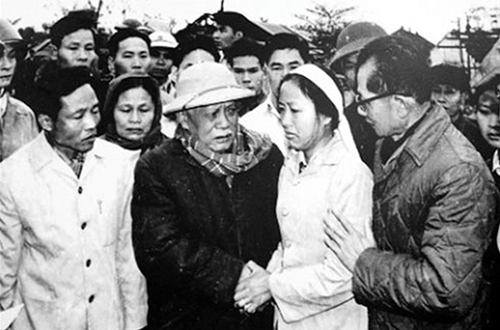    |
 |
|
On December 27, 1972, then State President Ton Duc Thang visits and encourages people and forces in Kham Thien Street after U.S. bombing on December 26, 1972. (A file photo) |
The State leader and the Commander-in-Chief encouraged people and forces in Kham Thien to overcome consequences of the bombing and turn pain into strength to shoot down bombers to revenge Vietnamese troops and people on the enemy.
On the same day, General Vo Nguyen Giap came to the Command of the Air Defense - Air Force Service. On praising troops of the Air Defense - Air Force Service for achieving great feats-of-arm on December 26 night, the Commander-in-Chief of the Vietnam People’s Army urged them to shoot down more B-52 bombers to take revenge on the enemy for killing people in Kham Thien and other areas.
In the morning, the U.S. mobilized 100 sorties of tactical aircraft to attack areas in Hanoi, such as March 8 Textile Factory, Van Dien station and warehouse, Duong Bridge, Gia Lam, missile and radar units.
Anti-aircraft batteries fiercely fought back. At night, the enemy mobilized more 36 sorties of B-52s and 66 sorties of tactical aircraft to raid Dong Anh, Yen Vien, Bach Mai, Khuyen Luong, Da Phuc, Duc Noi, and Co Loa. The sorties of B-52s were interspersed with sorties of F-111 fighters.
At about 11.20 p.m, pilot Pham Tuan, flying a MiG-21, was ordered to take off from Yen Bai airport, crossing the enemy’s protective barrier of F-4 fighters to approach and shoot down a B-52 in a close distance.
That was the first B-52 shot down by the Vietnamese air force in this campaign. On the whole day of December 27, the Vietnamese troops and people in the North shot down 14 aircraft, including five B-52s.
Translated by Tran Hoai